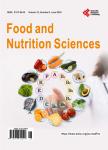Hepatic Protective Effects of <i>S</i>-Allyl-L-Cysteine (SAC) in Rats with Carbon Tetrachloride (CCl<sub>4</sub>) Induced Liver Injury
Hepatic Protective Effects of <i>S</i>-Allyl-L-Cysteine (SAC) in Rats with Carbon Tetrachloride (CCl<sub>4</sub>) Induced Liver Injury作者机构:Department of Pathology College of Veterinary Medicine Kyungpook National University Daegu Republic of Korea Stem Cell Therapeutic Research Institute Kyungpook National University Daegu Republic of Korea Department of Pathology College of Veterinary Medicine Gyeongsang National University Jinju Republic of Korea Department of Pharmacy College of Pharmacy Pusan National University Busan Republic of Korea
出 版 物:《Food and Nutrition Sciences》 (食品与营养科学(英文))
年 卷 期:2020年第11卷第12期
页 面:1053-1069页
学科分类:07[理学] 0701[理学-数学] 070101[理学-基础数学]
主 题:S-Allyl-L-Cysteine (SAC) Garlic Hepatic Protective Effects Carbon Tetrachloride Rats Hepatic Steatosis Cytochrome P4502E1
摘 要:S-allyl-L-cysteine (SAC) is an organosulfur compound derived from aged garlic extract (AGE). Studies have reported that AGE possesses bioprotective capacity, including antidiabetic, antimicrobial, antioxidant, and antitumor effects. The present study examined the protective effects of SAC against carbon tetrachloride (CCl4) induced hepatotoxicity in rats. Ten male Wistar rats aged 11 - 12 weeks were randomly divided into two groups (five rats/group) as control and SAC groups. All rats had ad libitum access to water, and the SAC group received water containing SAC intragastrically (200 mg/kg) once daily for five consecutive weeks. In the fifth experimental week, 50% CCl4 in olive oil (1 mL/kg) was administered intraperitoneally three times a week to induce liver injury in both groups. Rats were sacrificed at 24 hours after the last CCl4 injection, and liver tissues were excised for histopathological, immunohistochemical and antioxidant analyses. The rats in the SAC group did not show abnormal behavior, such as decreased water intake or food consumptio



